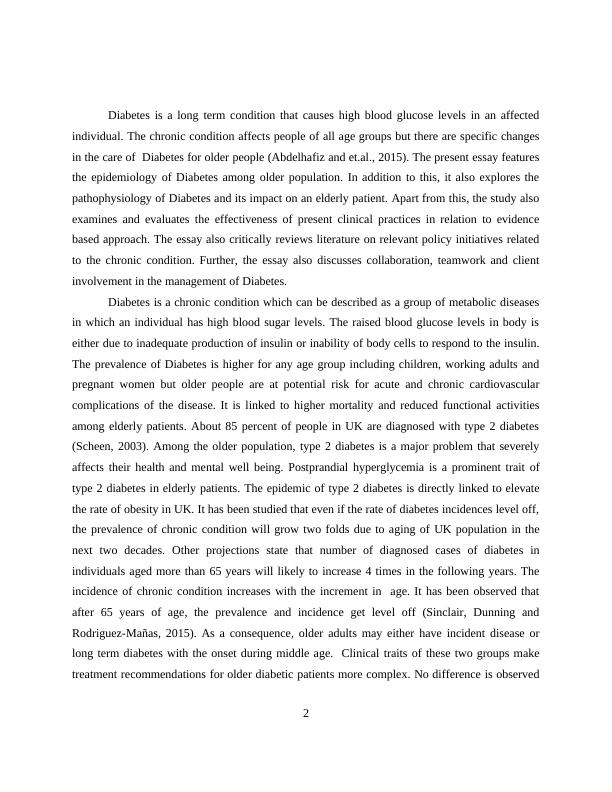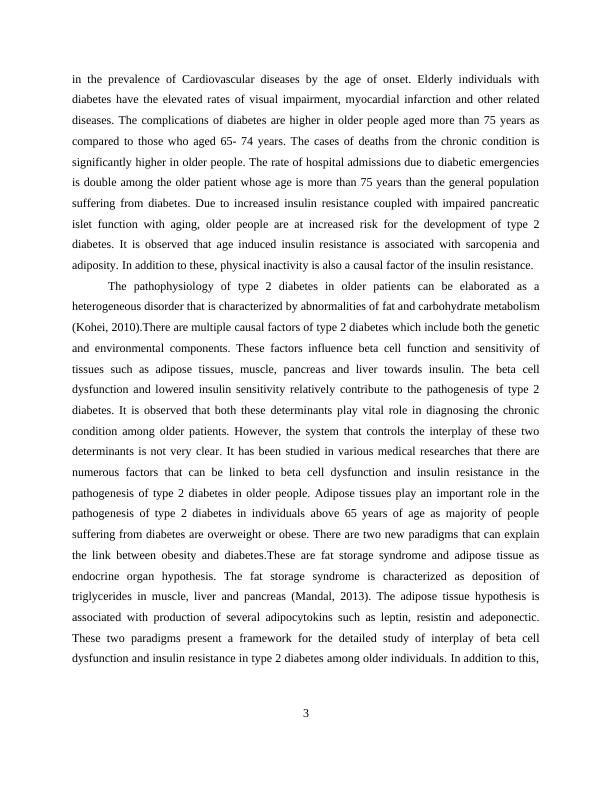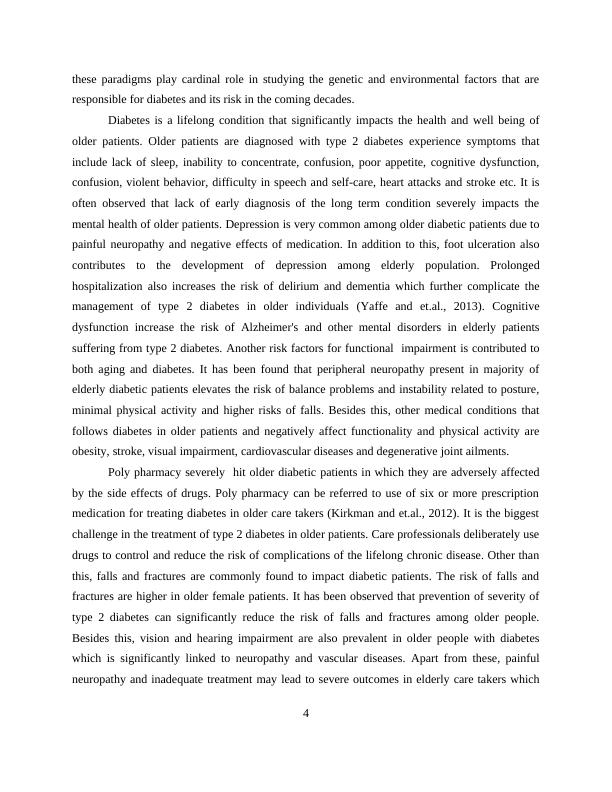The Epidemiology of Diabetes - Essay
Added on 2019-12-04
11 Pages4000 Words154 Views
Diabetes

Diabetes is a long term condition that causes high blood glucose levels in an affectedindividual. The chronic condition affects people of all age groups but there are specific changesin the care of Diabetes for older people (Abdelhafiz and et.al., 2015). The present essay featuresthe epidemiology of Diabetes among older population. In addition to this, it also explores thepathophysiology of Diabetes and its impact on an elderly patient. Apart from this, the study alsoexamines and evaluates the effectiveness of present clinical practices in relation to evidencebased approach. The essay also critically reviews literature on relevant policy initiatives relatedto the chronic condition. Further, the essay also discusses collaboration, teamwork and clientinvolvement in the management of Diabetes.Diabetes is a chronic condition which can be described as a group of metabolic diseasesin which an individual has high blood sugar levels. The raised blood glucose levels in body iseither due to inadequate production of insulin or inability of body cells to respond to the insulin.The prevalence of Diabetes is higher for any age group including children, working adults andpregnant women but older people are at potential risk for acute and chronic cardiovascularcomplications of the disease. It is linked to higher mortality and reduced functional activitiesamong elderly patients. About 85 percent of people in UK are diagnosed with type 2 diabetes(Scheen, 2003). Among the older population, type 2 diabetes is a major problem that severelyaffects their health and mental well being. Postprandial hyperglycemia is a prominent trait oftype 2 diabetes in elderly patients. The epidemic of type 2 diabetes is directly linked to elevatethe rate of obesity in UK. It has been studied that even if the rate of diabetes incidences level off,the prevalence of chronic condition will grow two folds due to aging of UK population in thenext two decades. Other projections state that number of diagnosed cases of diabetes inindividuals aged more than 65 years will likely to increase 4 times in the following years. Theincidence of chronic condition increases with the increment in age. It has been observed thatafter 65 years of age, the prevalence and incidence get level off (Sinclair, Dunning andRodriguez-Mañas, 2015). As a consequence, older adults may either have incident disease orlong term diabetes with the onset during middle age. Clinical traits of these two groups maketreatment recommendations for older diabetic patients more complex. No difference is observed2

in the prevalence of Cardiovascular diseases by the age of onset. Elderly individuals withdiabetes have the elevated rates of visual impairment, myocardial infarction and other relateddiseases. The complications of diabetes are higher in older people aged more than 75 years ascompared to those who aged 65- 74 years. The cases of deaths from the chronic condition issignificantly higher in older people. The rate of hospital admissions due to diabetic emergenciesis double among the older patient whose age is more than 75 years than the general populationsuffering from diabetes. Due to increased insulin resistance coupled with impaired pancreaticislet function with aging, older people are at increased risk for the development of type 2diabetes. It is observed that age induced insulin resistance is associated with sarcopenia andadiposity. In addition to these, physical inactivity is also a causal factor of the insulin resistance. The pathophysiology of type 2 diabetes in older patients can be elaborated as aheterogeneous disorder that is characterized by abnormalities of fat and carbohydrate metabolism(Kohei, 2010).There are multiple causal factors of type 2 diabetes which include both the geneticand environmental components. These factors influence beta cell function and sensitivity oftissues such as adipose tissues, muscle, pancreas and liver towards insulin. The beta celldysfunction and lowered insulin sensitivity relatively contribute to the pathogenesis of type 2diabetes. It is observed that both these determinants play vital role in diagnosing the chroniccondition among older patients. However, the system that controls the interplay of these twodeterminants is not very clear. It has been studied in various medical researches that there arenumerous factors that can be linked to beta cell dysfunction and insulin resistance in thepathogenesis of type 2 diabetes in older people. Adipose tissues play an important role in thepathogenesis of type 2 diabetes in individuals above 65 years of age as majority of peoplesuffering from diabetes are overweight or obese. There are two new paradigms that can explainthe link between obesity and diabetes.These are fat storage syndrome and adipose tissue asendocrine organ hypothesis. The fat storage syndrome is characterized as deposition oftriglycerides in muscle, liver and pancreas (Mandal, 2013). The adipose tissue hypothesis isassociated with production of several adipocytokins such as leptin, resistin and adeponectic.These two paradigms present a framework for the detailed study of interplay of beta celldysfunction and insulin resistance in type 2 diabetes among older individuals. In addition to this,3

these paradigms play cardinal role in studying the genetic and environmental factors that areresponsible for diabetes and its risk in the coming decades. Diabetes is a lifelong condition that significantly impacts the health and well being ofolder patients. Older patients are diagnosed with type 2 diabetes experience symptoms thatinclude lack of sleep, inability to concentrate, confusion, poor appetite, cognitive dysfunction,confusion, violent behavior, difficulty in speech and self-care, heart attacks and stroke etc. It isoften observed that lack of early diagnosis of the long term condition severely impacts themental health of older patients. Depression is very common among older diabetic patients due topainful neuropathy and negative effects of medication. In addition to this, foot ulceration alsocontributes to the development of depression among elderly population. Prolongedhospitalization also increases the risk of delirium and dementia which further complicate themanagement of type 2 diabetes in older individuals (Yaffe and et.al., 2013). Cognitivedysfunction increase the risk of Alzheimer's and other mental disorders in elderly patientssuffering from type 2 diabetes. Another risk factors for functional impairment is contributed toboth aging and diabetes. It has been found that peripheral neuropathy present in majority ofelderly diabetic patients elevates the risk of balance problems and instability related to posture,minimal physical activity and higher risks of falls. Besides this, other medical conditions thatfollows diabetes in older patients and negatively affect functionality and physical activity areobesity, stroke, visual impairment, cardiovascular diseases and degenerative joint ailments. Poly pharmacy severely hit older diabetic patients in which they are adversely affectedby the side effects of drugs. Poly pharmacy can be referred to use of six or more prescriptionmedication for treating diabetes in older care takers (Kirkman and et.al., 2012). It is the biggestchallenge in the treatment of type 2 diabetes in older patients. Care professionals deliberately usedrugs to control and reduce the risk of complications of the lifelong chronic disease. Other thanthis, falls and fractures are commonly found to impact diabetic patients. The risk of falls andfractures are higher in older female patients. It has been observed that prevention of severity oftype 2 diabetes can significantly reduce the risk of falls and fractures among older people.Besides this, vision and hearing impairment are also prevalent in older people with diabeteswhich is significantly linked to neuropathy and vascular diseases. Apart from these, painfulneuropathy and inadequate treatment may lead to severe outcomes in elderly care takers which4

End of preview
Want to access all the pages? Upload your documents or become a member.
Related Documents
Health issues in Gerontologylg...
|10
|3000
|421
The rate of other chronic health issuelg...
|9
|2700
|11
Diabetes Type II: Prevalence, Risk Factors, and Strategies for Preventionlg...
|6
|1623
|410
The National Health Priority Areas (NHPA)lg...
|9
|2380
|29
Integrated Nursing Practice | Assignmentlg...
|8
|1909
|13
Assignment on Fight Diabetes in your Community with NDSSlg...
|8
|1646
|10
